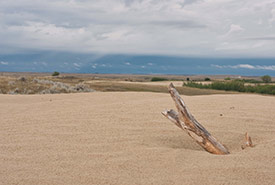Good news for Southwest Sandhills

Hardy vegetation in Southwest Sandhills, SK (Photo by Bill Armstrong)
Regina, SK (May 25, 2022) — The Nature Conservancy of Canada (NCC) announced today that SaskEnergy has provided $50,000 to support conservation and stewardship in the Southwest Sandhills in Saskatchewan. SaskEnergy’s support will fund research, conservation plans and partnerships to implement activities that will support the sustainable management of the area and a diversity of species, several of which are at risk.
The Southwest Sandhills are a delight for birdwatching and activities such as nature photography. Located west of Swift Current and extending to the Alberta border, the area features large tracts of intact native grasslands, sand dunes and sandy prairie, the Great Sand Hills, as well as a large section of the South Saskatchewan River.
The area is of historical, cultural and spiritual significance to many Indigenous Nations, with over 200 heritage resource sites of archaeological and cultural significance. The area also contains medicinal plants important to Indigenous Peoples.
The Southwest Sandhills area has a long history of supporting ranching. Grazing animals are an important part of the ecosystem and the economy of rural Saskatchewan; they help support a diversity of species as well as help maintain the health of grasslands. The area provides habitat for 39 species at risk, including burrowing owl, chestnut-collared longspur, piping plover, monarch butterfly and little brown myotis. This is also the only known area where the Ord’s kangaroo rat is found in the province.
SaskEnergy’s support will help fund the following conservation projects:
- Development of a 10-year Southwest Sandhills Natural Area Conservation Plan that outlines biodiversity targets and threats, partnerships and restoration projects. The plan includes input from Indigenous advisors and land users, as well as with a variety of agencies and stakeholders. The development of a new natural area conservation plan for this area was made possible thanks to partners such as SaskEnergy and funding through the Government of Canada’s Nature Fund.
- Public engagement events are planned for this summer (webinar August 4, in-person event August 13), hosted jointly between NCC, Nature Saskatchewan and Birds Canada. Participants will include landowners, land managers and land users in the area to discuss some of the conservation initiatives planned. For more information, contact kristen.martin@natureconservancy.ca
- A core working group including NCC, Nature Saskatchewan and Birds Canada has been formed to coordinate conservation efforts within the area. This partnership will help maximize the effective use of resources and funding by identifying opportunities for collaboration and partnerships.
- NCC is working with two community pasture patron groups within the area. This summer’s species at risk surveys and range health assessments will support grazing management plans for the pastures that address the challenges and resources of individual pastures. Developed in conjunction with pasture users, these plans will support decision-making processes that balance the economic needs and environmental pressures of the pasture.
“We are grateful for SaskEnergy’s support for NCC’s conservation work in the Southwest Sandhills area,” says Matthew Braun, program director of working landscapes for NCC in Saskatchewan. “This area contains unique habitats such as sand dunes, that support a diversity of species, including some that are found nowhere else in Saskatchewan. Support from partners such as SaskEnergy ensures that NCC’s work can continue to support these vital habitats and species over the long term.”
“SaskEnergy is a proud long-time sponsor of the NCC in its efforts to protect Saskatchewan’s natural spaces and the diversity of plant and wildlife species in areas such as the Southwest Sandhills,” SaskEnergy’s Acting President and CEO Mark Guillet said. “Protecting our province’s environment—including plant life, wildlife, wetlands, native prairie and at-risk species—is a big part of SaskEnergy’s commitment to environmental stewardship, along with reducing emissions from operations and supporting customers in reducing their end-use emissions.”
Facts
- Grasslands, and the wetlands they contain, are among the world’s most at-risk ecosystems. Over the past 25 years, Saskatchewan has lost more than 809,000 hectares of native grassland, and less than 20 per cent of native grassland now remains in our province.
- Grasslands filter our water, sequester and store carbon and are a critical part of Saskatchewan life. Grasslands also support prairie wildlife, including burrowing owl, swift fox, pronghorn, songbirds and migratory birds. For more information, visit conservegrasslands.ca
- NCC provides volunteer opportunities to help with on-the-ground stewardship of grasslands and wetlands. For upcoming events, visit conservationvolunteers.ca.
- NCC provides public on-foot access to most of its properties. To plan your next adventure, visit naturedestinations.ca.
About
The Nature Conservancy of Canada is the nation's leading land conservation organization, working to protect our country’s most important natural areas and the species they sustain. Since 1962, NCC and its partners have helped to protect 14 million hectares (35 million acres) coast to coast to coast. In Saskatchewan, more than 198,219 hectares (489,810 acres) have been protected. To learn more, visit natureconservancy.ca.
SaskEnergy delivers safe, reliable and affordable natural gas to homes, businesses and industry throughout Saskatchewan. SaskEnergy provides critical energy for a greener Saskatchewan and is committed to reducing emissions from operations by 35 per cent by 2030, compared to 2019 levels.





